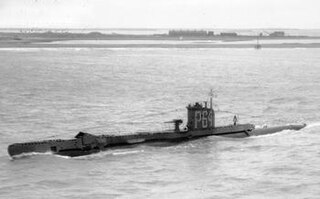
His Majesty's Naval Base, Clyde, primarily sited at Faslane on the Gare Loch, is one of three operating bases in the United Kingdom for the Royal Navy. It is the navy's headquarters in Scotland and is best known as the home of Britain's nuclear weapons, in the form of nuclear submarines armed with Trident missiles.

The Bay class was a class of 26 anti-aircraft (A/A) frigates built for the Royal Navy under the 1943 War Emergency Programme during World War II. They were based on the hulls of incomplete Loch class anti-submarine (A/S) frigates.

The Caledonian MacBrayne fleet is the largest fleet of car and passenger ferries in the United Kingdom, with 34 ferries in operation, 2 on charter and another 6 on order. The company provides lifeline services to 23 islands off the west coast of Scotland, as well as operating routes in the Firth of Clyde.
HMS Enard Bay was a Bay-class anti-aircraft frigate of the British Royal Navy, named for Enard Bay in Caithness.
HMS Largo Bay was a Bay-class anti-aircraft frigate of the British Royal Navy, named for Largo Bay in Fife.

HMS Widemouth Bay was a Bay-class anti-aircraft frigate of the Royal Navy, named for Widemouth Bay in Cornwall.

HMS Dalrymple was a Bay-class anti-aircraft frigate of the British Royal Navy, which served as a survey ship, mostly in the Persian Gulf, from 1948 until 1965. She was completed to deal with the large numbers of uncharted wrecks and mines around the British Isles as a result of World War II. For this purpose she was fitted for minesweeping. She was named for the pioneering Hydrographer of the Admiralty Alexander Dalrymple (1737–1808).
HMS Owen was a Bay-class frigate built for the Royal Navy during World War 2.

HMS Vandal (P64) was a Royal Navy U-class submarine built by Vickers-Armstrong at Barrow-in-Furness, yard number 838. The submarine had the shortest career of any Royal Navy submarine, being lost with all 37 onboard just four days after commissioning.

Henry Robb, Limited, known colloquially as Robbs, was a Scottish shipbuilding company based at Leith Docks in Edinburgh. Robbs was notable for building small-to-medium sized vessels, particularly tugs and dredgers.

HMS Loch Katrine was a Loch-class frigate of the British Royal Navy, built by Henry Robb at Leith, Scotland, and named after Loch Katrine in Scotland. The ship was laid down on 31 December 1943, launched on 21 August 1944, and completed and commissioned in December 1944. The ship served in World War II as a convoy escort in the Atlantic, and afterwards in the Indian Ocean. Decommissioned in May 1946, the ship was sold to New Zealand in 1948, and renamed HMNZS Rotoiti (F625). The ship saw active service during the Korean War, and was finally sold for scrap in 1965.

HMS Loch Arkaig was a Loch-class frigate of the British Royal Navy, named after Loch Arkaig in Scotland. The ship was ordered from Caledon Shipbuilding & Engineering Company, Dundee, Scotland, on 2 February 1943, and laid down on 1 November 1943. Launched on 7 June 1944, the ship was commissioned on 1 November 1945, and completed on 17 November. Unlike the rest of the class Loch Arkaig was fitted with Parsons single reduction geared turbines, rather than 4-cylinder vertical triple expansion reciprocating engines. The ship served in the Home Fleet until laid-up and put into Reserve in 1952, and was sold for scrapping in 1959.

SAS Transvaal was one of three Loch-class frigates in the South African Navy (SAN). She was built as HMS Loch Ard (K602) for the Royal Navy during World War II, but was transferred to the SAN in 1944 before completion and renamed as HMSAS Transvaal. The ship was completed shortly after the German surrender in May 1945 and did not participate in the war.
The following index is provided as an overview of and topical guide to Wikipedia's articles on recreational dive sites. The level of coverage may vary:

Recreational dive sites are specific places that recreational scuba divers go to enjoy the underwater environment or for training purposes. They include technical diving sites beyond the range generally accepted for recreational diving. In this context all diving done for recreational purposes is included. Professional diving tends to be done where the job is, and with the exception of diver training and leading groups of recreational divers, does not generally occur at specific sites chosen for their easy access, pleasant conditions or interesting features.

MV Loch Frisa is a ferry bought by Caledonian Maritime Assets for operation by Caledonian MacBrayne to serve between Oban and Craignure. She was originally named MV Utne and operated by Norled from 2015 to 2021. In December 2021, following a naming competition, CMAL announced her renaming as MV Loch Frisa.














